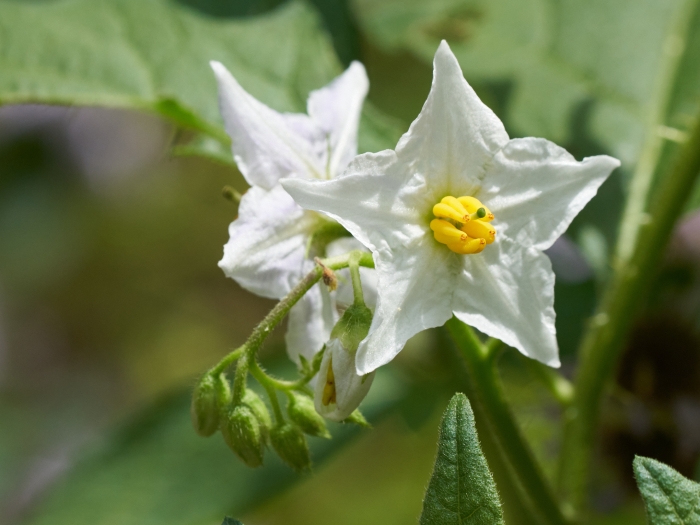Carolina Horsenettle
(Solanum carolinense)
Carolina Horsenettle (Solanum carolinense)
/
/

Linda Watson
CC BY 4.0
Image By:
Linda Watson
Recorded By:
Copyright:
CC BY 4.0
Copyright Notice:
Photo by: Linda Watson | License Type: CC BY 4.0 | License URL: http://creativecommons.org/licenses/by/4.0/ | Rights Holder: Linda Watson | Publisher: iNaturalist | Date Created: 2022-06-03T14:10:04-07:00 |









Estimated Native Range
Summary
Solanum carolinense, commonly known as Carolina horsenettle, is a perennial herb that is native to a variety of habitats including open woodlands, fields, pastures, and roadsides in the Eastern United States. It typically grows up to 35 inches tall and features prickly stems and leaves that emit a potato-like odor when crushed. The plant bears white to violet flowers with prominent yellow stamens, blooming from late spring to early fall. The flowers are followed by yellowish berries that may be poisonous.
Carolina horsenettle is known for its aggressive growth and can spread rapidly, making it a challenging weed in agricultural and disturbed areas. It is not typically cultivated due to its invasive nature and the potential toxicity of its berries. In terms of cultivation, it prefers full sun to part shade and is tolerant of a wide range of soil types, but it thrives in well-drained soils. While it is drought-tolerant once established, it can also tolerate moderate moisture levels. Gardeners should be cautious when handling this plant due to its prickly nature and potential skin irritation.CC BY-SA 4.0
Carolina horsenettle is known for its aggressive growth and can spread rapidly, making it a challenging weed in agricultural and disturbed areas. It is not typically cultivated due to its invasive nature and the potential toxicity of its berries. In terms of cultivation, it prefers full sun to part shade and is tolerant of a wide range of soil types, but it thrives in well-drained soils. While it is drought-tolerant once established, it can also tolerate moderate moisture levels. Gardeners should be cautious when handling this plant due to its prickly nature and potential skin irritation.CC BY-SA 4.0
Plant Description
- Plant Type: Shrub, Herb
- Height: 1-3 feet
- Width: 1-3 feet
- Growth Rate: Moderate, Rapid
- Flower Color: Purple
- Flowering Season: Spring, Summer, Fall
- Leaf Retention: Deciduous
Growth Requirements
- Sun: Full Sun
- Water: Medium, High
- Drainage: Medium, Fast
Common Uses
Bee Garden, Bird Garden, Butterfly Garden, Deer Resistant
Natural Habitat
native to a variety of habitats including open woodlands, fields, pastures, and roadsides in the Eastern United States
Other Names
Common Names: Carolina Horsenettle, Devil’s Tomato, Ball Nightshade, Ball-Nettle, Bull Nettle
Scientific Names: , Solanum carolinense, Solanum carolinense f. albiflorum, Solanum carolinense f. carolinense, Solanum carolinense var. albiflorum, Solanum carolinense var. floridanum, Solanum carolinense var. pohlianum, Solanum floridanum, Solanum floridanum, Solanum floridanum
GBIF Accepted Name: